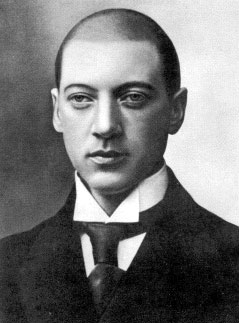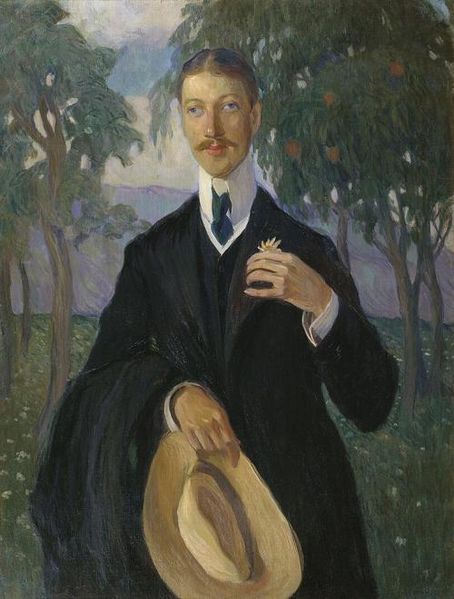<Back to Index>
- Physicist Johannes Stark, 1874
- Poet Nikolay Stepanovich Gumilev, 1886
- 8th Prime Minister of Australia Stanley Melbourne Bruce, 1883
PAGE SPONSOR


Nikolay Stepanovich Gumilev (Russian: Никола́й Степа́нович Гумилёв, April 15 NS 1886 – August 1921) was an influential Russian poet who founded the acmeism movement.
Nikolai was born in the town of Kronstadt on Kotlin Island, into the family of Stepan Yakovlevich Gumilev (1836 – 1920), a naval physician, and Anna Ivanovna L'vova (1854 – 1942). His childhood nickname was Montigomo the Hawk's Claw. He studied at the gymnasium of Tsarskoe Selo, where the Symbolist poet Innokenty Annensky was his teacher. Later, Gumilev admitted that it was Annensky's influence that turned his mind to writing poetry.
His first publication were verses I ran from cities into the forest (Я в лес бежал из городов) on September 8, 1902. In 1905 he published his first book of lyrics entitled The Way of Conquistadors. It comprised poems on most exotic subjects imaginable, from Lake Chad giraffes to Caracalla's crocodiles. Although Gumilev was proud of the book, most critics found his technique sloppy; later he would refer to that collection as apprentice's work.
From 1907 and on, Nikolai Gumilev traveled extensively in Europe, notably in Italy and France. In 1908 his new collection Romantic Flowers appeared. While in Paris, he published the literary magazine Sirius, but only three issues were produced. On returning to Russia, he edited and contributed to the artistic periodical Apollon. At that period, he fell in love with a non-existent woman Cherubina de Gabriak. It turned out that Cherubina de Gabriak was the literary pseudonym for two people, a disabled schoolteacher and Maximilian Voloshin, and on November 22, 1909 he had a duel with Voloshin over the affair.
Like Flaubert and Rimbaud before him, Gumilev was fascinated with Africa and travelled there almost each year. He hunted lions in Ethiopia and brought to the Saint Petersburg museum of anthropology and ethnography a large collection of African artifacts. His landmark collection The Tent (1921) collected the best of his poems on African themes. In 1910, Gumilev fell under the spell of the Symbolist poet and philosopher Vyacheslav Ivanov and absorbed his views on poetry at the evenings held by Ivanov in his celebrated "Turreted House". His wife Anna Akhmatova accompanied him to Ivanov's parties as well. Gumilev and Akhmatova married on April 25. On September 18, 1912, their child Lev was born. He would eventually become an influential and controversial historian. Dissatisfied with the vague mysticism of Russian Symbolism, then prevalent in the Russian poetry, Gumilev and Sergei Gorodetsky established the so-called Guild of Poets,
which was modeled after medieval guilds of Western Europe. They
advocated a view that poetry needs craftsmanship just like architecture
needs it. Writing a good poem they compared to building a cathedral. To
illustrate their ideals, Gumilev published two collections, The Pearls in 1910 and the Alien Sky in 1912. It was Osip Mandelstam, however, who produced the movement's most distinctive and durable monument, the collection of poems entitled Stone (1912). According to the principles of acmeism (as
the movement came to be dubbed by art historians), every person,
irrespective of his talent, may learn to produce high quality poems if
only he follows the guild's masters, i.e., Gumilev and Gorodetsky.
Their own model was Théophile Gautier, and they borrowed much of their basic tenets from the French Parnasse.
Such a program, combined with colourful and exotic subject matter of
Gumilev's poems, attracted to the Guild a large number of adolescents.
Several major poets, notably Georgy Ivanov and Vladimir Nabokov, passed the school of Gumilev, albeit informally. When
World War I started, Gumilev hastened to Russia and enthusiastically
joined a corps of elite cavalry. For his bravery he was invested with
two St. George crosses (December 24, 1914 and January 5, 1915). His war poems were assembled in the collection The Quiver (1916). In 1916 he wrote a verse play, Gondla, which was published the following year; set in ninth century Iceland, torn between its native paganism and Irish Christianity,
it is also clearly autobiographical, Gumilev putting much of himself
into the hero Gondla (an Irishman chosen as king but rejected by the jarls,
he kills himself to ensure the triumph of Christianity) and basing
Gondla's wild bride Lera on Gumilev's wife Akhmatova. The play was
performed in Rostov na Donu in 1920 and, even after the author's execution by the Cheka,
in Petrograd in January 1922: "The play, despite its crowd scenes being
enacted on a tiny stage, was a major success. Yet when the Petrograd
audience called for the author, who was now officially an executed
counter - revolutionary traitor, the play was removed from the repertoire
and the theatre disbanded." (In February 1934, as they walked along a Moscow street, Osip Mandelstam quoted Gondla's words "I am ready to die" to Akhmatova, and she repeated them in her "Poem without a Hero.") During the Russian Revolution, Gumilev served in the Russian expedition corps in Paris. Despite advice to the contrary, he rapidly returned to Petrograd. There he published several new collections, Tabernacle and Bonfire,
and finally divorced Akhmatova (August 5, 1918), whom he had left for
another woman several years prior. The following year he married Anna
Nikolaevna Engelhardt, a noblewoman and daughter of a well known
historian. "Despite the hard experiences of real travels and battles, he remained, to the end of his life, a schoolboy entranced by the Iliad of childhood - the adventures of Huckleberry Finn and Tom Sawyer. He never outgrew the influence of Mayne Reid, Alexandre Dumas, père, Jules Verne, Gustave Aimard and others." In 1920 Gumilev co-founded the All-Russia Union of Writers.
Gumilev made no secret of his anti - communist views. He also crossed
himself in public and didn't care to hide his contempt for half - literate Bolsheviks. On August 3, 1921 he was arrested by Cheka on
allegation of participation in monarchist conspiracy. Most literary
historians agree that it was not a Cheka fabrication, and Gumilev was a
likely conspirator. On August 24 the Petrograd Cheka decreed the execution of all 61 participants of the Tagantsev Conspiracy, including Nikolai Gumilev. The exact dates and locations of their execution and burial are still unknown. According to Rayfield's book 'Stalin and his Hangmen', the murder of Gumilev grew out of the consequences of the Kronstadt Rebellion. The sailors of Kronstadt, in Petrograd,
had protested against the new Bolshevik state in 1921. Rayfield asserts
that the Cheka blamed the intellectuals of the city. A Chekist named Iakov Agranov came
up with a plan to attack them. He tricked a local professor into
performing dissident acts, then arrested the professor and forced him
to name 300 'conspirators'. Agranov told him none of the named people
would be killed. However, 100 were killed, and Gumilev was one of
these. After appeals from Gorky and
others, Lenin agreed to pardon a small number of the condemned, but the
Cheka officer in charge carried out the execution order so quickly that
the pardon came too late. Gumilev is thought to have been buried in the Kovalevsky Forest. Hayward,
in an introduction to a book of Akhmatova's poetry, writes that the
execution placed a stigma on Anna and her son with Nikolai, Lev. Lev's
arrest in the purges and terrors of the 30s were based simply on his
being his father's son. Gumilev's
direct influence on Russian poetry was short lived. The sentiment is
best expressed by Nabokov, who once remarked that Gumilev is the poet
for adolescents, just as Korney Chukovsky is the poet for children. His most durable verse, written in mystical strain, appeared in the collection The Pillar of Fire (1921). Although
"banned in the Soviet times, Gumilev was loved for his adolescent
longing for travel and giraffes and hippos, for his dreams of a
fifteen year old captain" and was "a favorite poet among geologists,
archaeologists and paleontologists." His "The Tram That Lost Its Way" is considered one of the greatest poems of the 20th century. When Mikhail Sinelnikov was asked to study the archives of the late Mikhail Zenkevich, the last of the Acmeists - his teacher - he "found piles of secreted verse, an unpublished novel, manuscripts which Pasternak brought
to the old master to be critiqued, the poems and letters of his
friends. According to Sinelnikov, "at the bottom of a wide box lay a
copy of Izvestia Petrosovieta with
a list of people executed in connection with the Tagantsev case. The
type was barely legible, more like wisps of old wool. Some names, those
of Zenkevich's acquaintances, were ticked off. Gumilev's name was
underlined in red."
